
German postcard by Ross Verlag, no. 6835/1, 1931-1932. Photo: Ufa. Ery Bos in Schuß im Morgengrauen/A Shot at Dawn (Alfred Zeisler, 1932).
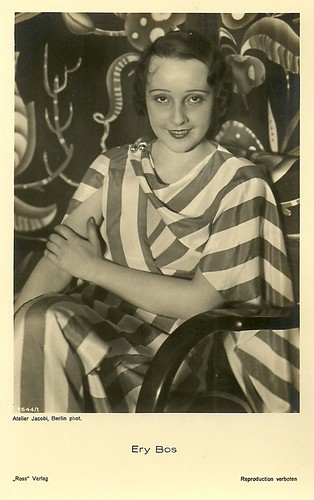
German postcard by Ross Verlag, no. 7644/1, 1932-1933. Photo: Atelier Jacobi.
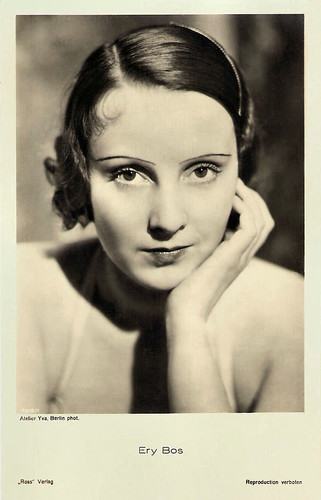
German postcard by Ross Verlag, no. 7919/1, 1932-1933. Photo: Atelier Yva, Berlin.
Solo dancer and choreographer
Erika Bos was born in Berlin, Germany in 1908 (some sources say 1910). She was the daughter of the internationally renowned Dutch composer and pianist Coenraad V. Bos and singer Elsa Stein.
At the age of 10, she already had dance classes and as a 13-year-old she performed in a production by Leni Riefenstahl in Berlin. She first attended public attention as a solo dancer in the 1920s and at 17 she was already a solo dancer in the city of Dortmund.
At the end of 1925, she was in the Amsterdam Central Theater with a dance performance under the guidance of her father. In 1928, Bos was a solo dancer and choreographer at the Opera Graz. The following year. she was again both solo dancer and choreographer at the Stadstheater Augsburg, and then followed an engagement in 1931 at the Stadstheater Bremen, again as solo dancer and choreographer.
The beautiful dancer also followed speaking lessons by Ilka Grüning. In Graz she played in 'Die Dreigroschenoper' (The Threepenny Opera) by Bertolt Brecht, later she joined Josef Jarno's company in Vienna. In the early 1930s, she played with Fritz Rotter in Berlin. There she was noticed by the film director Alfred Zeisler of the major German film studio Ufa.
Ery made her film debut in a lead role in his crime film Schuß im Morgengrauen/Shot at Dawn (Alfred Zeisler, 1932) opposite Peter Lorre. Her other films that year were Liebe in Uniform/Love in Uniform (Georg Jacoby, 1932) and Unmögliche Liebe/Crown of Thorns (Ery Grünfeld, 1932) in which she appeared as a daughter of Asta Nielsen. In the early 1930s, Ery Bos would play in 12 films.

German collectors card in the 'Der Künstlerische Tanz' series by Eckstein-Halpaus, Dresden, group 2, no. 102. Photo: Robertson.

German collectors card in the series 'Vom Werden Deutscher Filmkunst - Der Tonfilm', album no. 11, picture no. 129, group 44. Photo: Ufa / Ross Verlag. Karl Ludwig Diehl, Ery Bos, Theodor Loos and Fritz Odemar in Schuss im Morgengrauen/A Shot at Dawn (Alfred Zeisler, 1932).

German collectors card by Ross Verlag for Jasmatzi Cigarettenfabrik G.m.b.H., Dresden, in the series 'Hänsom Filmbilder, Serie V, Bild no. 84 (1-147). Photo: Ufa. Ery Bos, and Peter Lorre in Schuss im Morgengrauen/A Shot at Dawn (Alfred Zeisler, 1932).

Austrian collectors card by Bensdorp, Wien, Serie G, no. 324. Photo: Ross / Gnom Tonfilm.
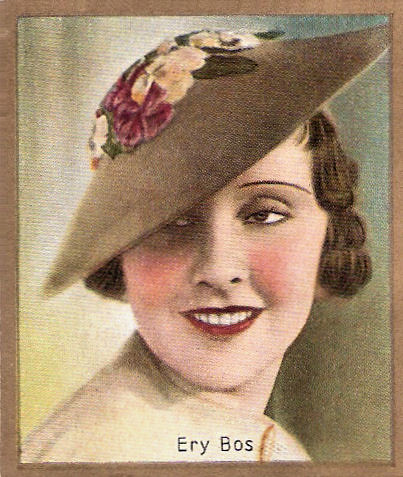
German collectors card by Salem Zigaretten in the series Bunte Filmbilder, no. 269 (in a series of 275). Photo: Dührkoop / Ross Verlag.
Escaping the holocaust
After Adolf Hitler and the Nazis had gained power in January 1933, the assignments of Ery Bos gradually dried up. In 1933, she played parts in Roman einer Nacht/Story of a Night (Carl Boese, 1933) and Der Zarewitsch/The Czarevitch (Victor Janson, 1933) starring Márta Eggerth.
Her final films were Mit dir durch dick und dünn/With you through thick and thin (Frans Seitz, 1934), Du bist entzückend, Rosmarie!/You are adorable, Rosmarie! (Hans von Wolzogen, 1934), Jede Frau hat ein Geheimnis/Every Woman Has a Secret (Max Obal, 1934) with Karin Hardt, and Grüß' mir die Lore noch einmal/Greet Lore again for me (Carl Heinz Wolff, 1934).
On stage, she played in the season 1934-1935 at the Berliner Komödie. Then the Jewish actress fled the country, escaping the holocaust. In London, Ery Bos married the Jewish businessman Herbert Grünfeld in 1938.
In 1941 Erika and her husband crossed the Atlantic Ocean to Canada. In 1947, Herbert Grünfeld founded his successful company Metallurg Inc. op, a precursor to the current Dutch-American conglomerate AMG. The couple settled in the very prosperous New York suburb of Chappaqua.
Ery Grünfeld would never make another film. In 1958 she became an American citizen. In 2005, Erika Grünfeld died in Chappaqua (some sources say New Castle) in the state of New York at the age of 96.
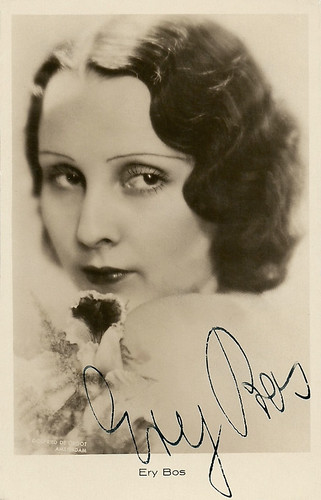
Dutch postcard. Photo: Godfried de Groot, Amsterdam. Collection: Didier Hanson.

German postcard by Ross Verlag, no. 8282/1, 1933-1934. Photo: Gnom-Tonfilm. Publicity still for Das Lied vom Glück/The Song of Happiness (Carl Boese, 1933). Collection: Geoffrey Donaldson Institute.

Dutch postcard by JosPe, no. 529.
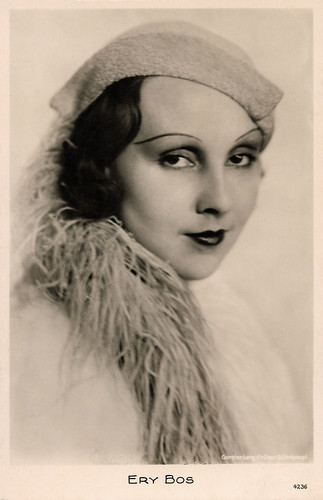
German postcard, no. 4236. Photo: Gerstenberg (earlier Dührkoop).
Sources: Thomas Staedeli (Cyranos), Rate Your Music, Wikipedia (German and Dutch), and IMDb.
This post was last updated on 15 July 2023.
No comments:
Post a Comment